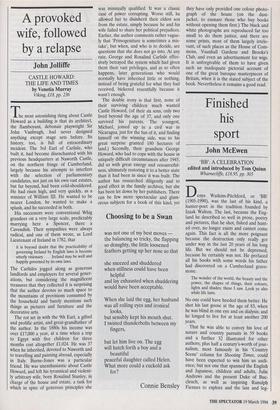A provoked wife, followed by a relapse
John Jolliffe
CASTLE HOWARD: THE LIFE AND TIMES by Venetia Murray Viking £18, pp. 236 The most astonishing thing about Castle Howard as a building is that its architect, the flamboyant, debonair playwright Sir John Vanbrugh, had never designed anything except stage sets before. Its history, too, is full of extraordinary incident. The 3rd Earl of Carlisle, who built it, had become disenchanted with his previous headquarters at Naworth Castle, on the northern fringe of Cumberland, largely because his attempts to interfere with the selection of parliamentary candidates, not just on his own vast estates, but far beyond, had been cold-shouldered. He had risen high, and very quickly, as a minister of William III. He wanted to be nearer London, he wanted to make a splash, and he succeeded in both. His successors were conventional Whig grandees on a very large scale, predictably marrying here a Spencer, there a Cavendish. Their sympathies were always radical, and one of them wrote, as Lord Lieutenant of Ireland in 1782, that it is beyond doubt that the practicability of governing Ireland by English laws is become utterly visionary . . . Ireland may be well and happily governed by its own laws.
The Carlisles jogged along as generous landlords and employers for several gener- ations, but considering the magnificent treasures that they collected it is surprising that the author devotes so much space to the mountains of provisions consumed by the household and barely mentions such things as pictures and furniture and the decorative arts.
The rot set in with the 9th Earl, a gifted and prolific artist, and great-grandfather of the author. In the 1880s his income was over £17,000 a year, at a time when a trip to Egypt with five children for three months cost altogether £1,024. He was 37 when he inherited, devoted to Naworth and to travelling and painting abroad, especially in Italy. Burne-Jones was a particular friend. He was unenthusiastic about Castle Howard, and left his tyrannical and violent- ly arbitrary wife, born Rosalind Stanley, in charge of the house and estate, a task for which in spite of generous principles she was minimally qualified. It was a classic case of power corrupting. Worse still, he allowed her to disinherit their eldest son from the estate, simply because he and his wife failed to share her political prejudices. Earlier, the author comments rather vague- ly that 'Primogeniture is sometimes a mis- take', but when, and who is to decide, are questions that she does not go into. At any rate, George and Rosalind Carlisle effec- tively betrayed the system which had given them their vast privileges, and as so often happens, later generations who would normally have inherited little or nothing, instead of being grateful for what they had received, bickered resentfully because it wasn't enough.
The double irony is that first, none of their surviving children much wanted Castle Howard, (of their six sons, only two lived beyond the age of 37, and only one survived his parents. The youngest, Michael, joined up in a civil war in Nicaragua, just for the fun of it, and finding himself on the winning side, was to his great surprise granted 180 hectares of land.) Secondly, their grandson George Howard, who had to cope with the house in uniquely difficult circumstances after 1945, did so with great energy and resourceful- ness, ultimately restoring it to a better state than it had been in since it was built. The author has researched diligently and to good effect in the family archives, but she has been let down by her publishers. There can be few more spectacular and glam- orous subjects for a book of this kind, yet they have only provided one colour photo- graph of the house (on the dust- jacket, to ensnare those who buy books without opening them first.) The black and white photographs are reproduced far too small to do them justice, and there are some prints, most of them largely irrele- vant, of such places as the House of Com- mons, Vauxhall Gardens and Brooks's Club, and even an advertisement for wigs. It is unforgivable of them to have given such an inadequate pictorial account of one of the great baroque masterpieces of Britain, when it is the stated subject of the book. Nevertheless it remains a good read.


























































 Previous page
Previous page